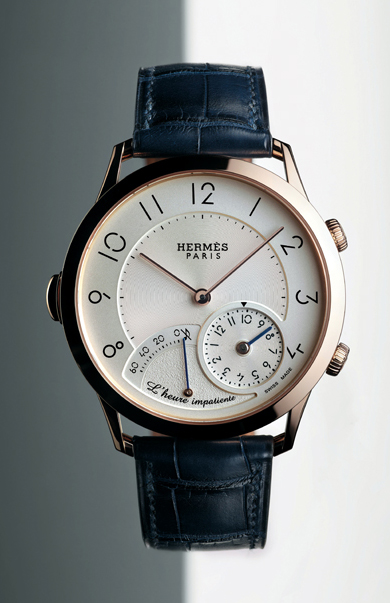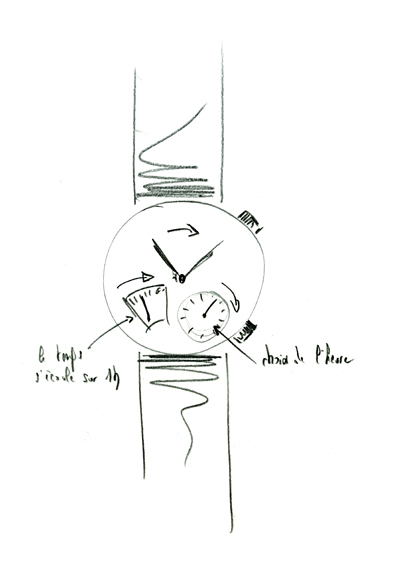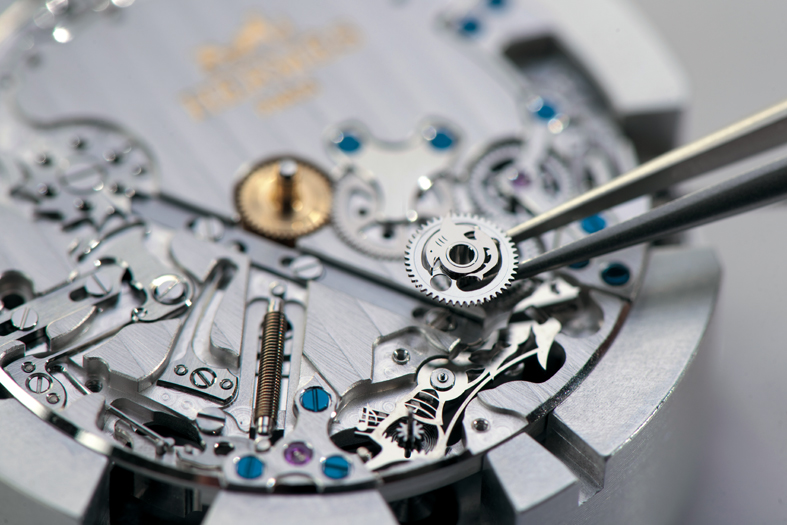Prestige issue 285, July-Aug.-Sept. 2017
«At Hermès, technology serves creation»
Hermes creates items born from an exceptional know-how, to make them fit to the personality of those who wear them. Time at Hermes is also an object, but the House dares another time intended to provoke emotions. The Slim watch from Hermès L’Heure impatiente, a true mechanical hourglass, multiplies these emotions and invites us to rejoice at the coming moment. Philippe Delhotal and Jean-Marc Wiederrecht unveil to Prestige this complication.

Since when have you collaborated in the design of new timepieces? Philippe Delhotal: The collaboration with Jean-Marc is an old story of complicity. We made Le Temps Suspendu together. In 2012 I had retained a phrase from a famous French politician, Georges Clemenceau, who said: «In love the most important thing is the stair mounting, that’s all there is before an expected moment». The quote from Clemenceau reminded me that what is important in life is this excitement, that impatience that takes place before. We all have situations in life that cause this impatience to set in. This retrograde is, in my opinion, an emotional crescendo, it is a magnifying glass on this hour, it is a focus. The first sketches of the watch resulted in the current model. The original was on a piece of paper, a scribble. It was in 2012. The adventure is spread over five years during which there have been periods of research, but also periods of doubt. The finalization was done by Jean-Marc and his team. When we decided to make this particular graphics, I told Pierre Alexis that we would have to find a competent graphic designer, since the box is relatively simple in form. He gave me the name of a person, Philippe also, whom I went to see. Jean-Marc is more than a partner, he is an accomplice.
What were the challenges of such a movement? Jean-Marc Wiederrecht: There were several. The Slim line came three years after starting the project. Then we had to put in a particular box, which increased the challenges. We were focused on a work of sound, although the main aspect of the project was focused on the hour before, materializing that hour which was to end with a sound. This sound had to be as beautiful as a timbre and last long enough to be heard. With a small movement, like the Hermes 1912, we had realized, the year before, the Perpetual with two zones. But in the Slim line that had to be thin, we had taken 2.60mm thick for the H1950 flattened movement, and added 1.4mm for the module, resulting in a 4mm perpetual calendar. It was the same problem here, but we had to have a free zone for the sound to develop, to have room for a 4mm high hammer that had to be as massive as possible, without adding any thickness to the movement. We achieved a tour de force by adding 1.2mm more than the movement of 23.9mm in diameter, to leave room for the rather special timbre between the movement and the box.


How did you manage to adapt the mechanics to the design? Jean-Marc Wiederrecht: We made 28 tests with two kinds of alloys, to have two positions. As the watch will ring twice a day, we have found a way to stop it and restart it, according to envy. If we fix it at 4 in the afternoon, we do not necessarily want it to ring at 4 in the morning. So we have to have that function to allow us to interact with the watch, as in le Temps Suspendu. We wanted to show all the time that remains until the event, to make the moment a privileged one. Philippe’s career was completely design. For this model, we have been in the details, and many times the position, the diameter, and many things have changed. We start from the design to then adapt the mechanics accordingly, while most of the time one starts from the mechanics and the designers then make the case. Philippe Delhotal: At Hermès, it is technique that is at the service of creation and not the other way around.
In which workshops has this movement been worked? Philippe Delhotal: We have our suppliers but one thing is certain: the watchmaker who starts the movement, finishes it.
And where were the case and the dial produced? Philippe Delhotal: The case and the dial are manufactured here. The hands are the only components we do not have internally.
Who puts the movement inside the case? Philippe Delhotal: We have specific workshops to make the casing, take the movement, the dial, the hands and assemble them.

Hermès does not seek to master time, nor to sequence it, is it a paradox for a watchmaker or does it allow you to play? Jean-Marc Wiederrecht: I made 15 years at the bench to master the computer in order to make the constructions myself. Today I love playing with time, with all the normal functions. We begin to juggle with the words, with the concepts and then we draw the wheels to materialize the expectation. At Hermès we tell the story, then we do the mechanics.
Prestige celebrates its twenty years of Watches Guide, how do you evaluate the last twenty years of watchmaking? Jean-Marc Wiederrecht: These are years of intensive marketing, overproduction. We do not take the time to look forward, we live the present moment, with ephemeral concepts. The term manufacture is one of the worst words that has been used and overused. The «long time» is to work on watches that can be repaired, all after-sales service needs to be revisited. In recent years the watch industry has become a little sleepy. Today crafts are industrialized, unique pieces, monobrand shops, but also multi-brand boutiques, people who know the customers, who want to sell the product. There is also a lack of knowledge. Marketing is fundamental but it has taken up too much space. Philippe Delhotal: Today we want the industry to be creative, reactive, give happiness to people, both in the discovery of the product as well as for those who manufacture it. Interview Conducted in Basel by MARIA NADIM








